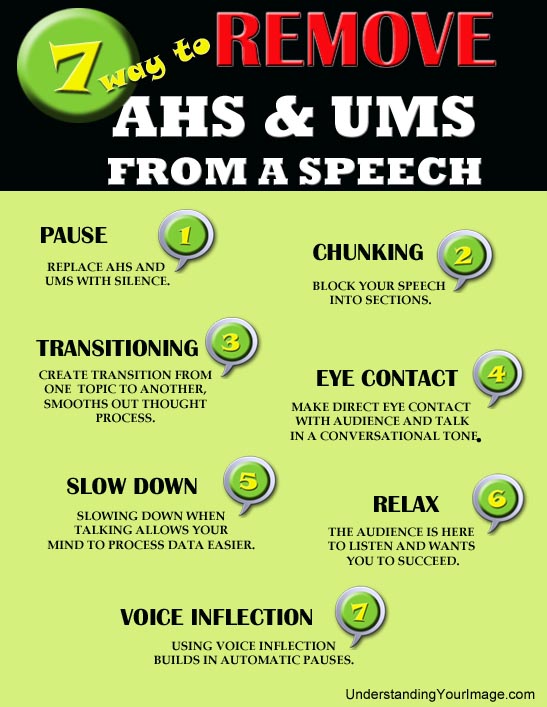
Pause – The Internet loves telling people to replace ahs and ums with a pause or silence. This is way easier said than done. Standing in front of a group of people and watching them stare back at you is not easy, and most advanced speakers find it difficult to do. Yet, with practice and understanding of the topic, you’re talking about, you’ll find it can be accomplished.
Chunking is taking a short segment of words or sentences and breaking them into chunks. When you chunk your speech, you create a rhythm: a burst of words/break/burst of words/break. Focus on that rhythm, and the ahs and ums slowly fade away. Just be careful. I have found when using this technique; I start talking like I’m reciting poetry or trying to wrap up the speech. My wife is quick to the point that out in practice.
Transition – Concentrate on the transitions you’re making from topic to topic. I’ve learned transitioning from one topic to another in one’s speech is a dangerous trap that generates ahs and ums, and we look for a way to transition to the next thought. This cognitive overload makes it easy for filler words to pop into your speech. Plan out exactly how your transitions will work and write them on an index card you can glance at during your speech.
Eye Contact – Look to make direct eye contact with your audience members. When you find that friendly face in the audience, you’ll notice that your speech becomes a conversion and your natural communication skills kick in, and the ahs and ums dissipate.
Slow Down – By slowing down your speaking pace, it allows your memory to keep in sync with your presentation. Because public speaking is not an everyday task for many people, their mind kicks into overdrive as the struggle to remember every little details, description, and nuance of a speech. This causes our inner voice to work faster, and we find that we forget what we said and backtrack, adding ahs & ums and filler words.

Relax – easier said than done. Nervousness brings out the dreaded filler words. How do we combat this? Remember, the audience is here to listen to you. They are not here to dispute what you say unless you are a politician. Every audience I have spoken to has been receptive to information. They may disagree with some of what I say, but overall they are happy to hear my ideas. I think they’ll like to hear yours too.
Remember, the more you practice, the more comfortable you’ll become with your presentation, and then it is easier to relax. Don’t let your inner voice put you down… you can do this!
Voice Inflation – I didn’t think this would work until I tried it. Projecting one’s voice does help with reducing filler words. The energy, pitch, and projection eliminate the tendency to add an “uh,” making it more engaging for other people who are listening. As I practiced my speech, I found that I used different voice inflection as I “chunked” the text. I found it easier to remember my speech as my inner voice would say, “say that line softly.” My inner voice was working with me, helping and not putting negative thoughts in my head.
I hope these tips are useful and you care to share them with others interested in removing the ahs and ums from their speech. Become part of the tribe and subscribe to iTalkDEO.
Resource for this article
- http://www.speakingaboutpresenting.com/delivery/obama-eliminate-ums/
- http://www.artofmanliness.com/2012/06/14/becoming-well-spoken-how-to-minimize-your-uhs-and-ums/
- http://sixminutes.dlugan.com/stop-um-uh-filler-words/
- http://www.sales-training-lead-generation.com/sales-presentations-how-to-avoid-filler-words-ums-and-ahs/
- http://m.prdaily.com/Main/Articles/How_to_cut_the_ums_uhs_and_literallys_when_speakin_16513.aspx